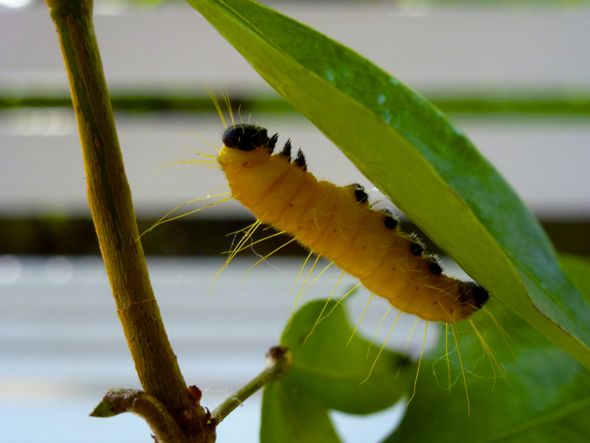Painted Jezebel (Delias hyparete metarete) caterpillars feed close together on leaves of their food plant for about 20 days (above). During this period they undergo five instars to grow to about 35mm x 4mm. The caterpillars then prepare to pupate.
In an effort to observe the caterpillars and the subsequent pupae, the branches of the Malayan Mistletoe (Dendrophthoe pentandra) where the caterpillars were located were cut and placed in a vase of water (above).
There, the fourth instar caterpillars underwent their last moult. And within a day or so the newly moulted caterpillars became restless (see video above). They moved rapidly up and down the branches. Reaching the ends, many raised the front half of the body and swirled it around, trying to make contact with nearby leaves or twigs in order to move forward. Unable to move further, they turned back and moved downwards. It was a sight to see them all moving about for hours on end. Some moved away from the vase to land on the ground.
This is a typical pre-pupation phenomenon. Were the branch still attached to the plant, these caterpillars would have moved a long distance away, each in a different direction to pupate. It would then be difficult to locate them. This is obviously a survival strategy, to pupate away from the feeding site and at different locations.
By nightfall most of the caterpillars had settled down, head uppermost. The anal end anchored the caterpillar to the leaf while a silken girdle around the middle stabilised the upper part (above). It is interesting to note that those about to pupate chose leaves that were not their food plant (placed in the vase to provide the caterpillars with more anchoring sites).
The next morning most of the caterpillars had settled down to pupate. The wriggling movement caused the outer skin to slowly split downwards. The V-shaped split can clearly be seen in the video above. The discarded skin was gradually pushed down as a crumpled mass and only when this mass reached the anal end was the conspicuous black head capsule apparent.
With further twisting of the lower end, the emerging pupa eventually pushed the discarded skin off the leaf (above shows the head capsule still attached to the leaf).
The image above shows a collection of discarded skin, prominent in the black head capsule, anal plates and the many long hairs.
Out of 26 caterpillars, 13 pupa were located. Of these, two were found under the table. The rest cannot be found. The change from caterpillar to pupa occurred more or less one after another within a period of less than an hour.
The newly emerged pupa continued to wriggle about for some time before settling down – see video below.
The next phase of the Painted Jezebel’s life cycle begins with the pupa preparing for eclosion.
YC Wee
Singapore
April 2015


![1. PaintedJezebel cat 4instar [wyc] - 2](https://besgroup.org/wp-content/uploads/1.-PaintedJezebel-cat-4instar-wyc-2.jpg)
![2. Malayan Mistletoe [wyc]](https://besgroup.org/wp-content/uploads/2.-Malayan-Mistletoe-wyc.jpg)

![4. PJ pupa 1d [wyc] - 3](https://besgroup.org/wp-content/uploads/4.-PJ-pupa-1d-wyc-3.jpg)
![5 . PJezebel cast-last moult to pupa [wyc] - 2](https://besgroup.org/wp-content/uploads/5-.-PJezebel-cast-last-moult-to-pupa-wyc-2.jpg)







2 Responses
To answer the question “Why do caterpillars move away from their food plant to pupate?”
I have observed two Jezebel caterpillars (from a batch of 18 ) pupate on leaves of their food plant. The other 16 moved to other plants nearby.
I watched as a younger batch of 12 caterpillars approach the 2 leaves of the pupating caterpillars! They completely consumed the leaves around the pupa; and the remnant bit of leaf with wriggly pupa dropped six floors down!
It was that period when my mistletoe plant was almost bare of leaves having had to support too many batches of caterpillars!